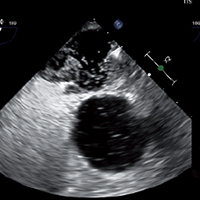Platypnea orthodeoxia syndrome in a patient with patent foramen ovale and normal atrial pressure. Case report and presentation of underlying pathophysiological mechanisms

Submitted: April 5, 2021
Accepted: June 13, 2021
Published: September 28, 2021
Accepted: June 13, 2021
Abstract Views: 1331
PDF: 552
Video 1: 144
Video 2: 156
Video 1: 144
Video 2: 156
Publisher's note
All claims expressed in this article are solely those of the authors and do not necessarily represent those of their affiliated organizations, or those of the publisher, the editors and the reviewers. Any product that may be evaluated in this article or claim that may be made by its manufacturer is not guaranteed or endorsed by the publisher.
All claims expressed in this article are solely those of the authors and do not necessarily represent those of their affiliated organizations, or those of the publisher, the editors and the reviewers. Any product that may be evaluated in this article or claim that may be made by its manufacturer is not guaranteed or endorsed by the publisher.
Similar Articles
- Gabriele Valli, Francesca De Marco, Maria Teresa Spina, Valentina Valeriano, Antonello Rosa, Valentina Minerva, Enrico Mirante, Maria Pia Ruggieri, Francesco Rocco Pugliese, A pilot study on the application of the current European guidelines for the management of acute coronary syndrome without elevation of ST segment (NSTEMI) in the Emergency Department setting in the Italian region Lazio , Monaldi Archives for Chest Disease: Vol. 82 No. 4 (2014): Cardiac series
- Paola Gremigni, Cynical hostility and the metabolic syndrome: A case-control study , Monaldi Archives for Chest Disease: Vol. 66 No. 3 (2006): Cardiac series
- Panagiotis Hountis, Maria Chounti, Chilaiditi’s sign or syndrome? Diagnostic question in two patients with concurrent cardiovascular diseases , Monaldi Archives for Chest Disease: Vol. 87 No. 2 (2017)
- Muhammad Ijaz, Muhammad Jaffar Khan, Jawad Khan, . Usama, Association of clinical characteristics of patients presenting with influenza like illness or severe acute respiratory illness with development of acute respiratory distress syndrome , Monaldi Archives for Chest Disease: Vol. 87 No. 1 (2017)
- Massimiliano Polastri, Lara Pisani, Andrea Dell'Amore, Stefano Nava, Revolving door respiratory patients: A rehabilitative perspective , Monaldi Archives for Chest Disease: Vol. 87 No. 3 (2017)
- Paolo Ruggeri, Federica Lo Bello, Francesco Nucera, Michele Gaeta, Francesco Monaco, Gaetano Caramori, Giuseppe Girbino, Hereditary hyperhomocysteinemia associated with nephrotic syndrome complicated by artery thrombosis and chronic thromboembolic pulmonary hypertension: A case report , Monaldi Archives for Chest Disease: Vol. 87 No. 3 (2017)
- Edoardo Sciatti, Enrico Vizzardi, Dario S. Cani, Assunta Castiello, Ivano Bonadei, Daria Savoldi, Marco Metra, Antonio D'Aloia, Kounis syndrome, a disease to know: Case report and review of the literature , Monaldi Archives for Chest Disease: Vol. 88 No. 1 (2018)
- Costantina Prota, Rodolfo Citro, Angelo Silverio, Roberto Ascoli, Corrado Naddeo, Giovanni Vitale, Federico Piscione, Thrombus straddling a patent foramen ovale , Monaldi Archives for Chest Disease: Vol. 80 No. 3 (2013): Cardiac series
- Roberto Porta, Laura Comini, Luca Barbano, Luca Bianchi, Michele Vitacca, A case of obstructive sleep apnea syndrome associated with floppy eyelid syndrome: positive effect of CPAP therapy , Monaldi Archives for Chest Disease: Vol. 87 No. 1 (2017)
- O. Serafini, G. Misuraca, A. Siniscalchi, M.T. Manes, G. Meringolo, C. Tomaselli, M. Chiatto, A. Buffon, Prevalence of aneurysm of the interatrial septum in the general population and in patients with a recent episode of cryptogenetic ischemic stroke: a tissue harmonic imaging transthoracic ecocardiography study in 5.631 patients , Monaldi Archives for Chest Disease: Vol. 66 No. 4 (2006): Cardiac series
You may also start an advanced similarity search for this article.

 https://doi.org/10.4081/monaldi.2021.1878
https://doi.org/10.4081/monaldi.2021.1878





